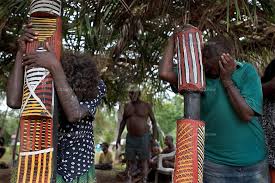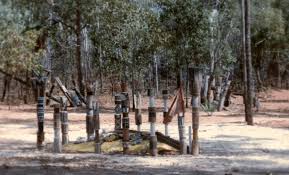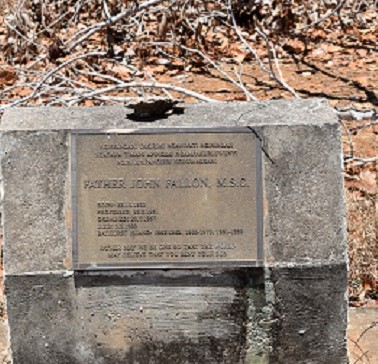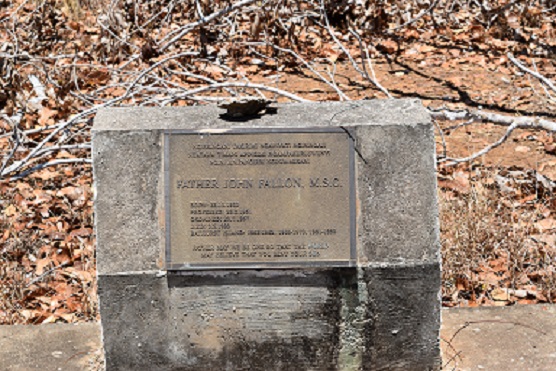A Tiwi Islands, MSC, culture story, Part 3, ‘The conversion of John Fallon’.
Converting the Church
Non-indigenous accounts of a "conversion" of the Church in the 1960s invariably turn to the Second Vatican Council. The Council itself has been described as "an event of conversion." The council's call, not only to respect other cultures, learn from them, propelled a shift in missiological theory and practice. It was Eurocentric. Yet it presented opportunities for the Church to embrace cultures and approaches from beyond Europe.
Nostra Aetate, for instance, taught that the Catholic Church "rejects nothing of what is true and holy" in non-Christian religion. Nostra Aetate opened possibilities for infusing the liturgy with Aboriginal symbols. Sister Robyn Reynolds, from the nearby Wadeye Aboriginal mission, argued that the Easter Wadeye Baptism, replete with Aboriginal symbolism, was a response by Aboriginal people to the call for liturgical inculturation. Aboriginal leader and former Missionaries of the Sacred Heart (MSC) priest, Patrick Dodson, also remembered the Council opened opportunities for encounters between Aboriginal ritual practices and the Roman rite (though he was ultimately disappointed, believing that, in Australia, the Council's vision of the "community of believers" drifted back to "hierarchy ... conformity and compliance").
When Fallon published an account of his "conversion" in a missionary magazine in 1991, he placed it firmly in the context of the Vatican II reforms. He likened his experience to St. Paul's and called it his "metamorphosis." His version has many similarities to Tiwi memories. The Pukumani had drawn people away from mass, so he disrupted it:

"It was a Sunday. There was nobody in the church - only a few - and I could hear the sounds of a Pukamani [sic] coming across the Aspley Strait from Paru, on Melville Island. My Mass was totally distracted - and made short! I got myself across the strait and immediately scolded the people in good dramatic language with all the show of anger and shame that I could muster. This was early in my zealous days. I even shook one of the sacred posts, belonging to Minnipinni, Thomas Woody's father. He asked me to stop. I didn't. Such a pagan symbol deserved shaking, just as they all did!
"I'd forgotten this part, but Thomas Woody reminded me in 1986 ... Within a fortnight of this happening I was on my way over to Paru once more ... when I lost a brand new Mercury 25HP outboard motor, over the side of the boat, never to be retrieved. So I was duly punished for shaking that post, according to Thomas."
Fallon did not mention who or what "punished" him. Did he believe in the mobuditi? Perhaps. Versed in St. Paul's dramatic conversion, Fallon might have understood that the mobuditi broke into his experience in a similar way, creating a spiritual rupture, turning him from misplaced zeal towards a deeper truth. Yet Fallon claimed he had forgotten this part of the story, so crucial in Tiwi versions. Writing for a non-Indigenous readership, perhaps uncomfortable with the possibility that a priest could experience the Tiwi spiritual world as a living reality, he attributed his change to intellectual reflection more than supernatural intervention.
Soon after these events, Fallon left the islands. This, he said, gave him the space to rethink his approach to mission. When he returned, the teachings of the Second Vatican Council were fresh in his mind - that is, "we enculturate Jesus' word with [other] cultures." For him, his conversion happened over a period of years, formed from reflection on his experiences with the Tiwi and the ideas coming from Rome.

The priests in the Northern Territory were intrigued by the cross-cultural opportunities of Vatican II. One reflected on the new thinking in the early 1970s. Pastors must "study the culture" in which they work and understand whether their liturgy is "attuned" to the people. Fallon suggested that the "Roman Rite" needed a more thoroughgoing cultural translation for the Tiwi context. He embraced ideas about what came to be called "inculturating" the Gospel. He not only learned to dance in the Tiwi way, but led a movement to bring the Pukumani into the Church.
In 1968, Fallon arranged for the installation of Pukumani poles in the Bathurst Island church; the legs of the altar would be made of six miniature poles. By 1975, missionaries were discussing including Pukumani dances in the funeral mass, including blessing the poles. These moves, they believed, would make Catholicism more comprehensible and attractive to Tiwi.
Perhaps it was simply coincidence that Fallon's conversion experience at the Pukumani took place during this period of "conversion" of the global Catholic Church. Yet, it could also be said that it was the Tiwi people - or even the mobuditi spirits - that caused the conversions of Vatican II to come alive in North Australia.

"God gave us culture, Tiwi culture"
On the question of their "conversion," the Tiwi acknowledge that they changed upon contact with missionaries. There was a time, before the mission, when they were not baptised and they did not know Catholic teachings. They speak quietly of "bad things" that they no longer practice. For Tiwi, these were not abandoned simply because missionaries insisted - missionaries, for instance, misjudged the Pukumani as a "bad thing" - instead, through discussion with missionaries (and not without conflict), Tiwi people decided they need not be intrinsic to their culture. They emphasise that Catholicism is perfectly consistent with Tiwi culture - "God gave us culture, Tiwi culture" - so it would be incorrect to consider their ancestors "pagan."
There has been some blending of ritual practice and story, led by Tiwi themselves. Tiwi people made parallels between Purrukapali and Adam, the Moon-Man and Christ in the 1960s. In the 1980s, Tiwi compared the Catholic service to their rituals, commenting, for example, that the use of incense in church was similar to their use of smoke. Tiwi women's songs include Catholic hymns translated into Tiwi. Other songs blend traditional Tiwi and Catholic spiritualities.
Despite these examples, I found Tiwi people reluctant to integrate Catholic and Tiwi ritual and story. An older woman explained to me that "we got two: Christian faith and our culture." Another explained that there is only piecemeal integration of Tiwi culture in the church, though she hoped it would become deeper. When I asked if there were parallels between biblical stories and the Purrukapali story (could, for example, Purrukapali be a Tiwi Adam?) I was told, "we've gotta still work it out"; there is a reluctance to make explicit parallels as priests have done. Some insisted that biblical stories were not equivalent to their stories.
From a missiological perspective, inculturation was always meant to be more than evangelising cultures in a "thin veneer" (to use the words of Pope Paul VI). The priests, no doubt, thought they were creating this deep engagement when permitting the Pukumani poles in church. Yet according to some Tiwi, there is remains a ritual shallowness to this engagement in the church. Yet this does not threaten their Tiwi Catholic identity, it points to the failure of the Church to convert fully to the Tiwi world.
From my understanding of the Fallon story, Tiwi Christianity meant - and means - waiting for the Church to change and turn to them, to overcome its homogeneity in favour of their localism and become embedded in their islands. As they insist through the Fallon story, especially his dancing, the real conversion was that of the Catholic Church becoming Tiwi.
The insight of the Tiwi perspective on conversion is that for people to become part of spiritual communities, the community and its spirituality change. Religious institutions themselves can be converted as the very people they include interpret their faith different ways. Tiwi memories reveal that, as the Church incorporates more peoples, it changes and grows. As it turns and embraces new peoples and cultures - even their ancestors and spirits as the Tiwi recognise - the Church is, in a sense, converted to them.
Laura Rademaker is a Postdoctoral Research Fellow in the Australian Catholic University's Institute for Religion and Critical Inquiry, and author of Found in Translation: Many Meanings on a North Australian Mission

